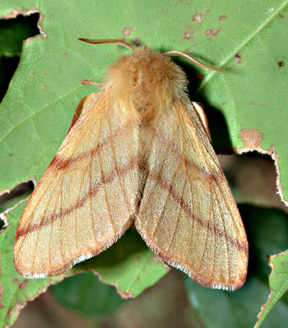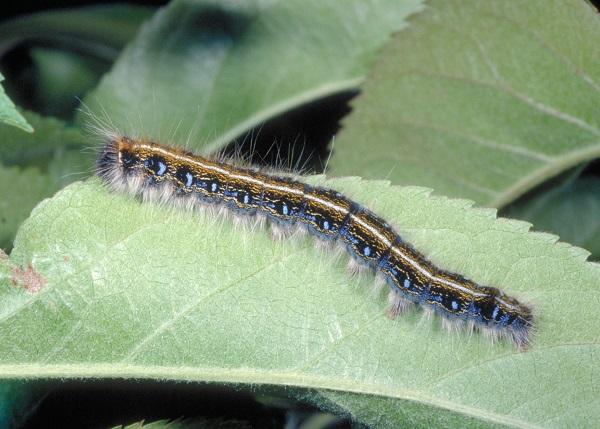
The webs made by tent caterpillars function as greenhouses that help these early-season feeders stay warm so disturbing the web puts substantial stress on the colony. They feed on cherry apple plum willow birch poplar and oak trees.

Gypsy moth caterpillars do not produce a web which distinguishes it from web-making caterpillars such as the Eastern tent caterpillar Malacosoma americanum and the fall webworm Hyphantria cunea.
Tent caterpillar lifespan. Larvae do not construct tents Life stage Length of time per individual Time of year Larva Caterpillar Pupa Cocoon Adult Moth 5 days July Egg Egg mass 5-6 weeks Early spring June 3 weeks June 10 months July - early spring. The forest tent caterpillar larvae also have a white hairy body with the matured ones growing to 5 65 cm long. A single egg mass results in 50 200 larvae at a time and they mostly move along in a colony throughout this period.
The silken sheets they make have pheromones that serve as social cues helping them move around with ease. The eastern tent caterpillar is of some importance as a pest because it defoliates ornamental trees. Damaged trees however typically recover and refoliate within several weeks.
Tent caterpillar outbreaks are cyclical some years worse than others. Our Malacosoma tent caterpillars are native forest pests and despite their voracious appetites our forest trees can usually recover from the damage they inflict. Some years are definitely worse than others for tent caterpillar infestations.
Every 9-16 years the tent caterpillar. The life cycle starting with the cocoon spinning and ending with the cocoon part of the cycle again. All tent caterpillar species have one generation per year.
Adults live for only a few days during which they mate and lay eggs and do not feed. Immature tent caterpillars are colorful and about 1¾ inches long when fully grown. They have a few long hairs on their bodies mostly along the sides.
These webs are used to protect the caterpillars from predators and the elements. Although tent damage is unsightly infestations rarely threaten the lives of trees. Four species are commonly discussed.
Eastern Tent Caterpillar Malacosoma americanum Found east of the Rockies and north into southern Canada. Full grown caterpillars 2 inches long are sparsely hairy and black in. The Eastern Tent Caterpillar dark and hairy are popping up all over the state in recent weeks.
Heres what you need to know about these insects if they are. When tent caterpillar removal is necessary the nests or egg cases can usually be picked out by hand. Egg cases can be seen easily once leaves drop from trees in fall.
Larger nests can be removed by winding them around a stick or pruned out and destroyed. The best time for tent caterpillar removal is early morning or evening while theyre still likely to be in the nest. Eastern tent caterpillar webs are built in the crotch and the forks of the host plants limbs.
Also the eastern tent caterpillar begins building webs earlier in the growing season than forest tent caterpillars and is among the first insects to come out of their overwintering. The webs made by tent caterpillars function as greenhouses that help these early-season feeders stay warm so disturbing the web puts substantial stress on the colony. You can poke holes in the tents with a stick or long-handled apple picker and then twist to gather up caterpillars and webbing.
Older caterpillars are approximately 15 to 20 inches long. Gypsy moth caterpillars do not produce a web which distinguishes it from web-making caterpillars such as the Eastern tent caterpillar Malacosoma americanum and the fall webworm Hyphantria cunea. Life CycleWestern tent caterpillar has one generation per year.
White silken tents in the branches of host plants provide evi-dence of western tent caterpillar presence in spring. These are generally visible shortly after bud burst. Larvae live and feed as a colony enlarging the tent as.
The map below showcases in blue the states and territories of North America where the Forest Tent Caterpillar Moth may be found but is not limited to. This sort of data can be useful in seeing concentrations of a particular species over the continent as well as revealing possible migratory patterns over a species given lifespan. Adult forest tent caterpillar moths have a short 510 day lifespan Fitzgerald 1995 and even a short post-mating refractory period could significantly impact the likelihood that a mated male moth would orient to pheromone and be captured in a pheromone-baited monitoring trap.
The effect of mating on subsequent capture in pheromone-baited. You may encounter three species of tent caterpillar in Indiana. Forest tent caterpillar Malacosoma disstria Western tent caterpillar M.
Californicum and eastern tent caterpillar M. All three species live in groups of anywhere from 40 to 200 individuals that stay together until shortly before they pupate. The Western Tent Caterpillar is yellowish-brown with a row of blue and orange spots along their back.
They feed on cherry apple plum willow birch poplar and oak trees. The Forest Tent Caterpillar is similar looking to the Eastern Tent Caterpillar. They are black with white keyhole-shaped spots along their back.